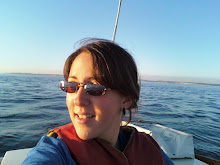Translated from Maori as, "Where whales journey, people follow."
This was the subtitle for the whale exhibition at the National Geographic Museum in Washington D.C. It was so artfully, skillfully, factually put together -- like walking into the pages of National Geographic, but much more interactive. The exhibition's acceptance of cultural traditions were wonderful and something that National Geographic has come to be known for.
The central exhibit was two sperm whale skeletons; one, a large male and the other a mature female with weakened bones. It was fascinating comparing the two to one another, side by side. Directly underneath the skeletons were some sort of black plexiglass and small lights. This created two wonderful effects that added a reflection of the skeletons from underneath, as well as producing dramatic shadows upon the ceiling.
In one corner of the room stood a small cave-like room. Once inside, I realized that the cave was shaped like the interior of a sperm whale's head. Towards the front was a screen that played a simulation video of a sperm whale diving for a squid, called "Search and Destroy." Like the rest of the exhibition, this film was exceptionally well done. It made no use of vocal narration and allowed visitors to focus on the whale's task.
A series of short films on "Whale People" were scattered around the perimeters of the room, spotlighting a few different people who study whales in New Zealand. Some were locals, others were foreign researchers who have come to love the country as well as the whales. Each video was a glimpse of the life of someone who lives in New Zealand and studies whales.
It's too bad I don't live nearer to D.C.; I would have enjoyed another visitor or two (or three!) to the Tohora exhibition. One day I'd like to go one better than an exhibit; one day I'd like to go to New Zealand and see for myself!
Sunday, November 30, 2008
Subscribe to:
Post Comments (Atom)

No comments:
Post a Comment